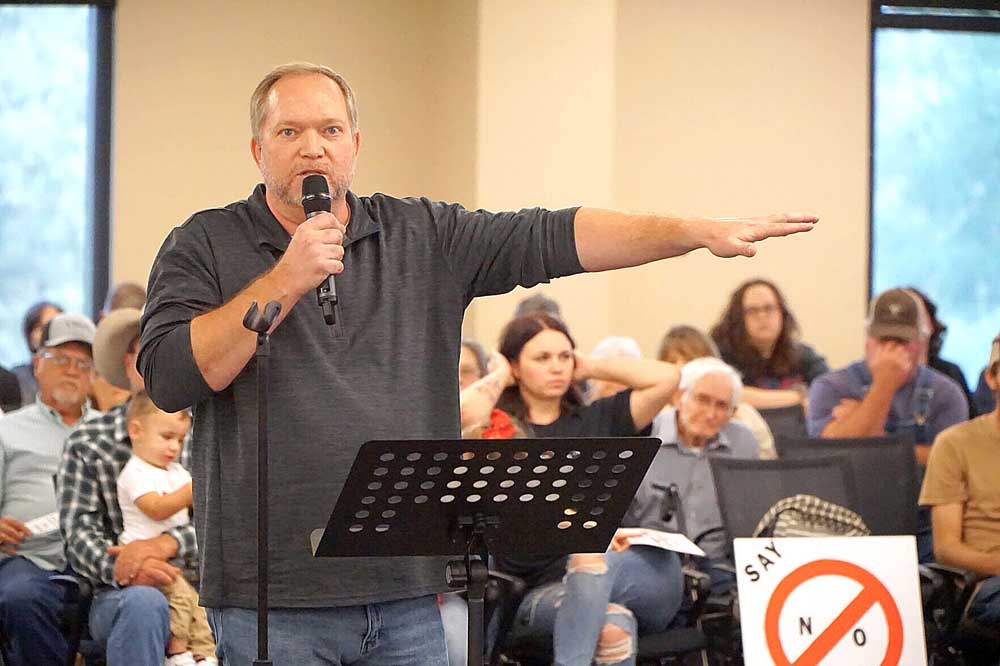Marvin Nichols Reservoir deemed feasible despite local opposition
Published 4:51 pm Monday, January 6, 2025

- Gary Cheatwood Jr. speaks against the proposed Marvin Nichols Reservoir project during a meeting Wednesday in Pittsburg. Cheatwood’s land in Red River County would be taken as part of the reservoir project. “I will not leave,” he said. (Jordan Green/Longview News-Journal Photo)
A newly released report found the Marvin Nichols Reservoir, a project that several Northeast Texans say would take away private land acreage to give Dallas-Fort Worth residents more water, would be considered feasible.
The reservoir would be located on the Sulphur Rivers and upstream at the White Oak Creek in Franklin, Titus and Red River counties. It is proposed to be supplying water by 2050.
Trending
According to the document, study found the project feasible in the following areas: its implementation timeline, the cost, land acquisition requirements and economic impact. However, this study is not used to show support or opposition toward the project or to determine if the reservoir should be built.
The purpose of Marvin Nichols is to add more water resources to the Region C Regional Water Planning Group area, which includes much of the Dallas-Fort Worth area and all or part of the 16 North Texas counties. The Region D Regional Water Planning Group, which includes counties in Northeast Texas, opposes the project due to anticipated impacts to agricultural resources, timber, natural resources, local economies and environmental considerations.
As of November, the reservoir is under consideration to be in 2026 Region C Regional Water Plan. According to the study, the project would store up to about 1.5 million acre-feet of water and provide over 450,000 acre-feet of water per year. Of the 450,000 acre-feet, the Region C plan assumes 361,200 would go to water providers in the DFW area and the remaining 20 percent would stay in the Sulphur Basin for local use.
For the project, the Texas Water Development Board requested public input associated with feasibility review. Ahead of the initial Dec. 1, 2023, deadline, TWDB received 120 submissions, including 20 from potentially impacted businesses, state Rep. Gary VanDeaver and Cass County Judge Travis Ransom.
From Dec. 2, 2023 to Sept. 15, TWDB received 241 public input submissions. While conducting the review, the board received 1,878 public input submissions.
“The vast majority expressed general opposition to the reservoir project but did not include substantive comments or additional relevant information either to inform the report or in response to the draft document,” the review read.
Trending
In 2023 dollars, the project is expected to cost just over $7 billion. The study found the cost would not make the project impossible.
The study found the reservoir would impact a “large quantity of high-quality acreage” under the definition by the United States Fish and Wildlife Service. The land requirements would be considered significant and play a big role in the final cost, but there’s no indication that these needs would make the reservoir unfeasible, the study said.
Economic impacts noted in the study include increased labor income, new residents and increased county tax revenue.
However, the study says no impacts were considered regarding timbering-associated services, impacts to beef cattle industry, impacts to land or economic losses to area hunting.
“This results in an underestimation of the full magnitude of these economic impacts of the project,” the study explained.
According to the document, it’s impossible to determine every economic impact, especially since this project won’t be online until 2050. There’s no economic impacts that would make the project infeasible.
The study was submitted to Legislative Budget Board and Gov. Greg Abbott.






